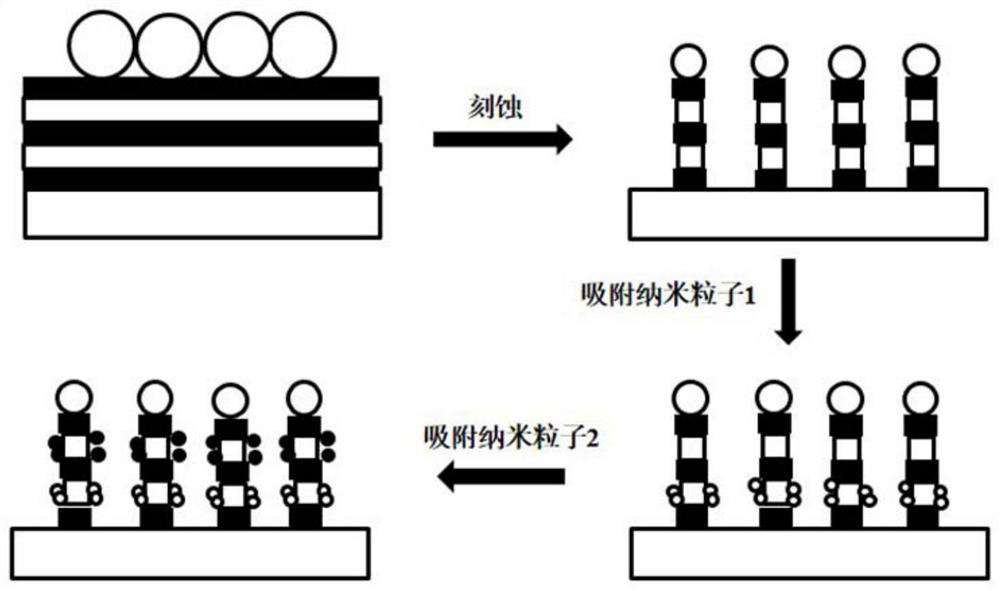A multi-segment barcode nanorod and its preparation method
A nano-rod and barcode technology, applied in the field of nano-coding materials, can solve problems such as limiting coding capacity, and achieve the effects of increasing coding capacity, low cost, and large coding capacity
- Summary
- Abstract
- Description
- Claims
- Application Information
AI Technical Summary
Problems solved by technology
Method used
Image
Examples
Embodiment 1
[0031] Multi-segment barcode nanorods, the preparation process of which is:
[0032] (1) The colloidal crystal etching method is used to construct multi-segment nanorod arrays. The construction flow chart is as follows figure 1 As shown, the details are as follows: firstly, different polymer solutions are sequentially deposited to form films on the surface of the same substrate (the substrate is a silicon substrate) by spin coating, and then silicon dioxide microspheres are assembled on the surface of the five-layer polymer film, and then the compact The stacked silica microspheres were etched into a non-close packed array by plasma etching technology, and finally the etched silica microspheres were used as a mask to etch the underlying five-layer polymer film to produce multi-segment nanometers. rod array; wherein, the average diameter of silica microspheres is 800nm, and different polymer solutions are: polystyrene (solvent is toluene), protonated poly(4-vinylpyridine) (solv...
Embodiment 2
[0037] Multi-segment barcode nanorods, the preparation process of which is:
[0038] (1) Colloidal crystal etching method was used to construct multi-segment nanorod arrays: firstly, different polymer solutions were sequentially deposited on the surface of the same substrate (the substrate was a silicon substrate) to form films by the drop coating method, and then deposited on the surface of the three-layer polymer film Assemble polystyrene microspheres, and finally use polystyrene microspheres as a mask to etch the lower three-layer polymer film to make multi-segment nanorod arrays; wherein, the average diameter of polystyrene microspheres is 300nm, and different polymers The solution is as follows: polyacrylic acid solution (solvent is ethanol), polystyrene (solvent is toluene) and polymethacrylic acid N,N-dimethylaminoethyl ester solution (solvent is chloroform) for each layer of polymer film deposited , the control base is tilted at a certain angle relative to the horizont...
Embodiment 3
[0043] Multi-segment barcode nanorods, the preparation process of which is:
[0044] (1) Colloidal crystal etching method is used to construct multi-segment nanorod arrays: firstly, different polymer solutions are sequentially deposited on the surface of the same substrate (the substrate is a silicon substrate) to form films by spin coating, and then deposited on the surface of the three-layer polymer film Assemble polystyrene microspheres, and finally use polystyrene microspheres as a mask to etch the underlying three-layer polymer film to make multi-segment nanorod arrays; wherein, the average diameter of polystyrene microspheres is 1 μm, and different polymers The product solution is followed by: thiol cross-linked polyamino acid solution (solvent is water), polymethacrylate N,N-dimethylaminoethyl ester solution (solvent is chloroform) and photoresist solution (product model is AZ4620 ); each time a polymer film is deposited, the substrate is controlled to incline at a cert...
PUM
| Property | Measurement | Unit |
|---|---|---|
| diameter | aaaaa | aaaaa |
| thickness | aaaaa | aaaaa |
| thickness | aaaaa | aaaaa |
Abstract
Description
Claims
Application Information
 Login to View More
Login to View More - R&D
- Intellectual Property
- Life Sciences
- Materials
- Tech Scout
- Unparalleled Data Quality
- Higher Quality Content
- 60% Fewer Hallucinations
Browse by: Latest US Patents, China's latest patents, Technical Efficacy Thesaurus, Application Domain, Technology Topic, Popular Technical Reports.
© 2025 PatSnap. All rights reserved.Legal|Privacy policy|Modern Slavery Act Transparency Statement|Sitemap|About US| Contact US: help@patsnap.com



